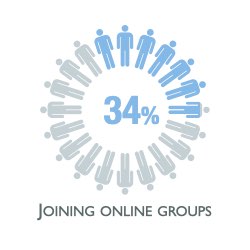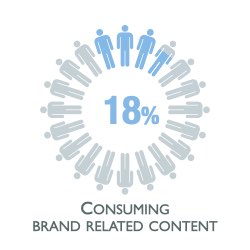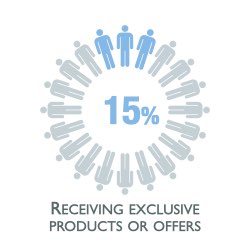There are numerous examples of B2C Brands leveraging the power of Campfire Communities to connect and communicate with consumers. It’s not surprising given that a recent Sprout Social research study found that 32% of respondents said they want to follow brands on social media that connect them to others like themselves.
The study went on to report…
- 91% of respondents believed in social media’s power to connect people
- 78% of them WANTED brands to use social media to help people connect with each other
- 31% of consumers said they were actively looking for communities to join
- 41% believed brands should create private communities on social media channels.
Oh, and if all that statistical goodness isn’t enough for you… try this last one on for size.
66% of respondents said they equated trust with connection.
Combine all of that with consumers ranking social media as the number one channel for building a connection between a brand and a consumer, and it all points to a simple fact: there is an audience out there actively looking for Campfire Brands & Campfire Communities. And anytime there is an audience actively looking for something, there is a benefit for smart B2B and B2C brands who choose to listen and deliver.
Community Drives Loyalty
And probably the single most important reason B2C (and we’d argue B2B) brands should create campfire communities is increased brand loyalty.
Just this month, a 2022 Clarus Commerce Customer Loyalty Data Study found that the 2nd most cited reason for brand loyalty (22%) is Strong Sense of Community. That’s not very far behind the #1 reason: Higher Quality Product at 27% and it’s actually HIGHER than the 3rd biggest brand loyalty driver: Better Prices, coming in at 17%.
Buyers, who felt that a strong sense of community drove their brand loyalty, say they want social media communities built around products or services.
The Clarus Study found the following activities were the most important for fostering a sense of community amongst those who consider community an important value.
Community Drives Social Agency
Loyal customers are more likely to engage with your brand and some of them might even become Social Agents. The Clarus Study asked respondents how often they’d interacted with their favorite brand over the last year. Check out the responses below. Pretty powerful support for investing your time in 2022 and beyond building out a robust Campfire Community so you can evolve into a true Campfire Brand.
Activity | Monthly | Rarely | Never |
|---|---|---|---|
Looked for news about the brand | 65% | 16% | 18% |
Searched for community events from the brand in my area | 58% | 19% | 37% |
Checked my loyalty status/points | 64% | 12% | 24% |
Posted about the brand on social media | 50% | 20% | 38% |
Tried a new product or service from the brand | 73% | 23% | 12% |
Made a major purchase with the brand | 46% | 27% | 27% |
And when those same respondents were asked:
When you think of your favorite brand, which of the following actions have you taken within the last 12 months?
Buying my favorite brand’s products regularly (at least once a month)
Telling my friends about my favorite brand
Participating in my favorite brand’s loyalty program
Providing feedback/filling out surveys from my favorite brand
Sharing personal data with my favorite brand
Posting about my favorite brand using their hashtags/handles
Attending an event hosted or sponsored by my favorite brand
The lesson here is that successful brands need to find ways to make deeper connections between their customers and their brands and products.
Community Drives Customer Dialogue & Insights
I cannot overstate the value of direct dialogue with your customers. Years ago, when we created our first ever Campfire Community for Metanx, we, and more importantly they, began discovering deep, underlying motivations and fears that were universally felt by all diabetics.
Fears and motivations that the diabetics themselves didn’t even realize were driving so much of their own actions. And as we continued to have campfire video chats, over the course of 18 months, these same underlying fears and motivations kept surfacing over and over again, even though we were doing nothing to stimulate them.
I’ve been in marketing for over 30 years. I’ve sat through more focus groups, eaten more M&M’s, and read more market research than I care to remember. And I can state unequivocally that I’ve never seen feedback like we were receiving. The level of honest, raw, unvarnished insight into the hearts and minds of the very consumers and Influencers we were trying to reach was truly mind boggling. And we didn’t even ask for this insight specifically. We started these campfires because we wanted their advice to ensure we properly approached the community with our social media and influencer outreach efforts. But because we took the time to ask, we received so much more.
At one point, these video chats became much bigger than Metanx or our social media marketing efforts. They became a bonding experience. A chance for a community of people to come together around a video campfire and just talk openly and freely without fear of their words being used against them. It became a chance to explore deep seated fears, hopes and questions in a safe, private environment of their peers - OWNED AND OPERATED BY A BRAND!!!!
Think about that for a moment… your brand as a campfire.
Community Reduces Sales & Marketing Expenses
From the insights we gathered via these campfire chats, the relationships formed and the TRUST developed between the community, their Influencers and the Client, we were able to launch the first ever worldwide Diabetes Hope Conference.
It drew 500 diabetics, diabetic influencers and even members of the medical community, to a half-day virtual conference. One of our client’s biggest competitors, a huge pharmaceutical company, also held an annual face-to-face conference targeting this same group of people.
Our client laughed all the way to the bank. The competitor’s conference was rumored to cost about $1,000,000 a year. Our virtual effort was less than $100,000. And because our community acted as a partner vs participant, we garnered promotional placements on two of the biggest diabetic community platforms in the world — placements that weren’t for sale and no company could purchase the space if they wanted to because it was exclusively for promoting the communities “own” events.
But we’re not the only ones finding campfire communities reduce sales and marketing expenses.
According to this article from Harvard Business Review, one company found it was 72% cheaper to answer a question via the brand’s community than through the company’s standard customer support group. And in real dollars, that equated to approximately $2.9 million per year.
A Community Roundtable 2020 report found that thriving online communities cost an average of $153 per member but generated $682 of value per member annually. And Dewalt, a power tool company, reportedly saved $6 Million in market research costs by creating an online community.Community Improves Sales Conversion
If you subscribe to the belief that people prefer to do business with people they know, like and trust, then it goes without saying that a robust, loyal community will produce a higher conversion percentage than the general populace.
But, for the data geeks here:
One report showed 66% of professionals saying that their online community has positively impacted customer retention, 68% stating that it has helped them generate new leads, and 55% professing that they have seen increased sales directly from the community.
Another showed nine out of ten consumers read reviews before buying a product. Thus, a brand community full of real experiences and opinions can and will influence not only other community members but more importantly, thanks to Google, non-members
A Case For Building A Campfire Community
If your brand can benefit from:
Then maybe you should find some matches, some wood and a good place to go build your very own campfire. And if you think you might like a bit of help, call us.
This post was originally published on Painless Prospecting, the weekly sales and marketing blog created by the fine folks at Converse Digital. If you want to learn how to create, engage in, and convert conversations into new clients and customers, give them a call.





